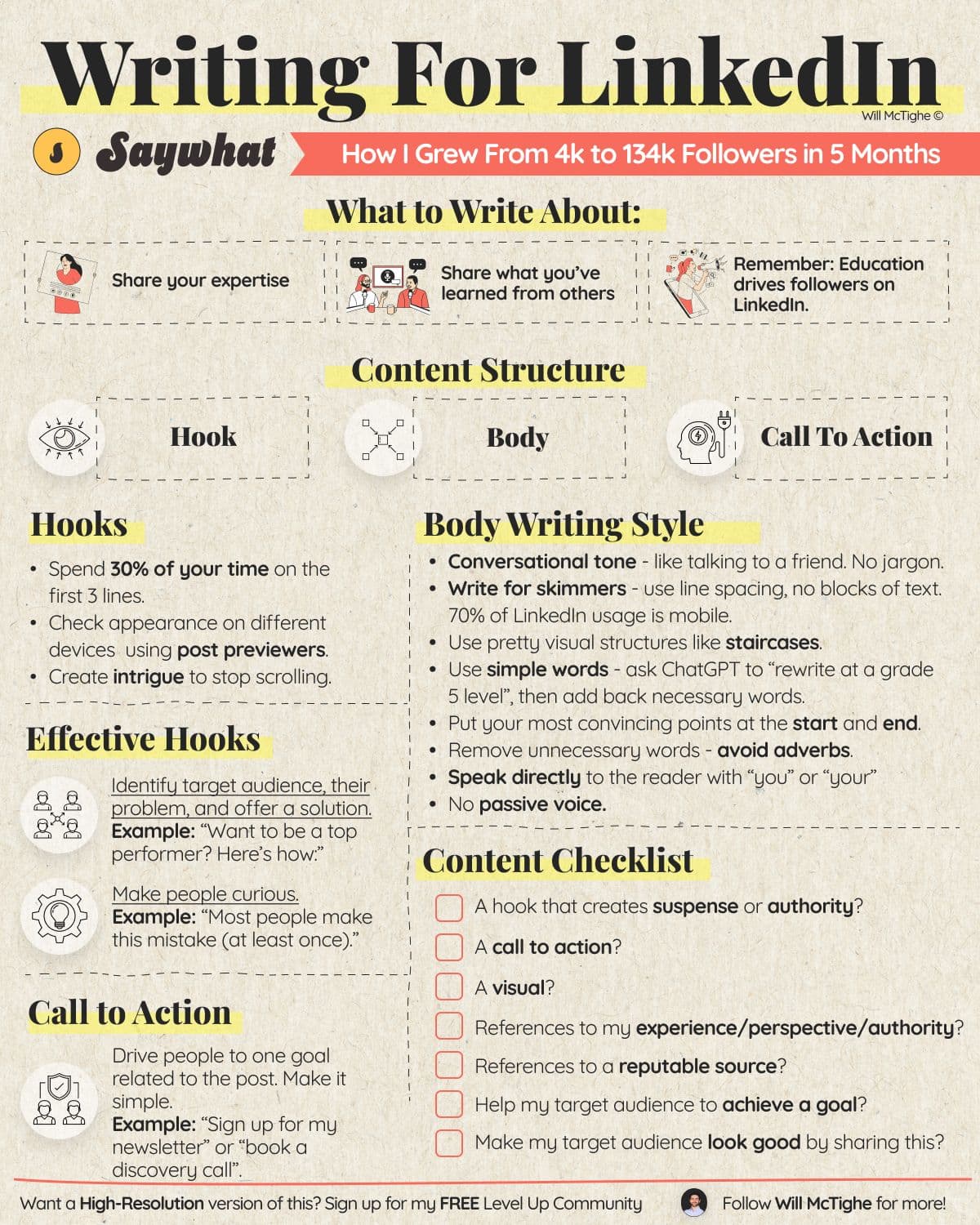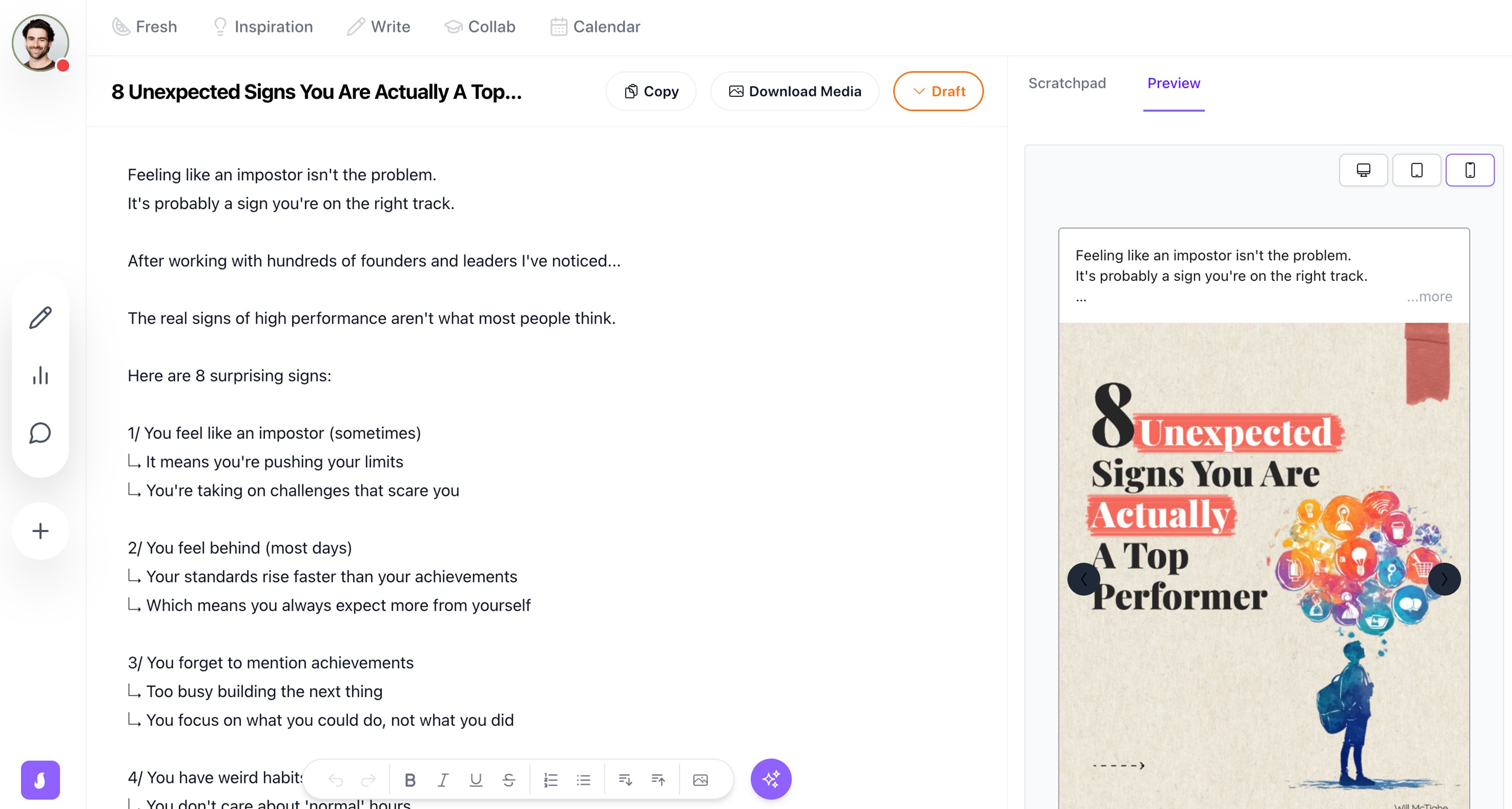
How to Write Viral Content for LinkedIn

Will McTighe
September 17, 2024
Introduction
It's Will McTighe here. When I started my LinkedIn journey in February 2024, I had just 3,000 followers. Fast forward to March 2025, and I'm now at >340,000 followers. This >110x growth didn't happen by accident - it came from making mistakes and understanding the platform's algorithm, audience psychology, and content optimization strategies that I'm about to share with you.
What Should I Write About?
Share What Matters to Your Audience
Talk about what you know or what you’re learning that your target audience wants to hear. On LinkedIn, people follow you for education. Share your best ideas for free, and then offer services to help implement them later.
Start with proven topics
When you’re just starting out, focus on writing about topics that have already proven successful in your niche. This means choosing subjects that have worked well for others in the past. Read my guide to 15 proven viral LinkedIn topics to get content ideas.
To find content ideas, use tools like Saywhat (LinkedIn viral content database) or Favikon (which finds successful content from big creators on Instagram, Twitter, and TikTok). Saywhat has a trending topics database you can check out to get started.
Study the successful posts from larger creators in your niche to understand what people enjoy - from the topics they cover to the formats they use. Once you have a good idea of what resonates, start creating your own content!
How to Write Great LinkedIn Content
There are three important parts to a written post:
- Hook
- Body
- Call to Action
How To Write Hooks
Spend 30% of your time on the first 3 lines. Come up with multiple versions of it. Wait till you’re done writing the whole post then finalize the hook. The hook is your first impression. Your goal is to create intrigue to stop scrolling. Check its appearance on different devices before posting using Saywhat or Kleo's post previewer.

P.S. Your visual is part of your hook. See my viral visual on ways to win back time as an example.
Body & Writing Style
A few important tips:
- Write in a Conversational Tone: Avoid jargon! Imagine you are talking to a friend.
- Write for Skimmers: No long blocks of text. >70% of LinkedIn usage is on mobile. Use lots of line spacing, and easy-to-read text structures (staircases, etc).
- Remove Unnecessary Words: Use Grammarly to proofread your text. Make sure each word earns its place. Use tools like Hemingway Editor to make it concise and direct.
- Use Simple Punchy Language: After I finish writing a post, I put it through ChatGPT with the prompt “please rewrite this at grade 5-7 reading level and make it punchier and more succinct” and edit from there.
- Avoid Passive Language: Don’t use the passive voice or adverbs. Focus on active, clear statements.
- Highlight Key Points: Place your best points at the beginning and end of your post to capture and retain attention.
How To Write Call to Actions (CTA)
There’s only one rule for good CTAs: simple and actionable. Your CTA should have ONE clear message and ONE action for your readers.
Examples: “Sign up for my newsletter” or “Book a discovery call”.

The 7-Step LinkedIn Content Checklist
Here’s a content checklist I developed over the last 12 months. It will make your content creation process more efficient, especially when you’re starting out.
Once you’re done writing (and editing), check to see if your post includes:
- A hook that creates suspense or authority?
- A call to action?
- A beautiful visual?
- Does it help my target audience to achieve a goal?
- Does my target audience look good by sharing this?
- References your experience/perspective/authority?
- References a reputable source?
Conclusion
Growing on LinkedIn is not rocket science. It's just about showing up consistently, knowing who you're talking to, and giving them something valuable every time you post.
The journey from 4,000 to 340,000 followers taught me that LinkedIn rewards creators who focus on quality over quantity, who deliver value to their audiences, and who format their content for easy reading and engagement.
Growth takes time. It happens through consistent posting, experimentation, learning from results, and adapting your approach. You can build your own audience by starting with proven topics, crafting "scroll stopping" hooks, writing conversationally, and including clear calls to action.
The most important thing: Just start. Today. Then do it again tomorrow. Use the 7-step checklist to make sure your posts hit the mark, and don't be afraid to be yourself. Your unique perspective is what will make you stand out.
Want to make this process a little easier?
Saywhat's AI powered writing assistant will write drafts for you so you don't have the blank page problem!
Start building your personal brand today.
Join top executives and creators in using our AI-powered writing, community, and lead gen tools to scale your LinkedIn business.
